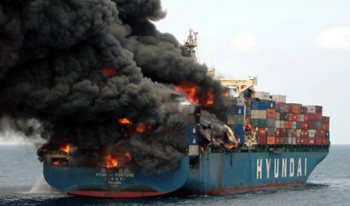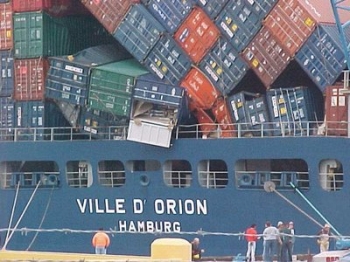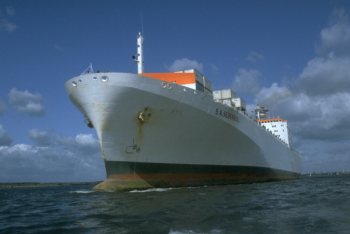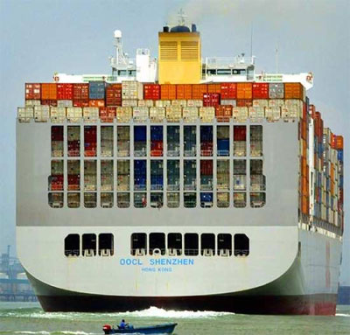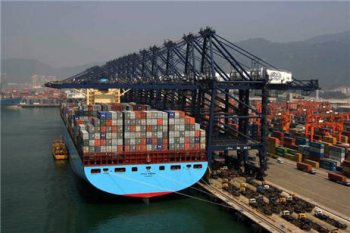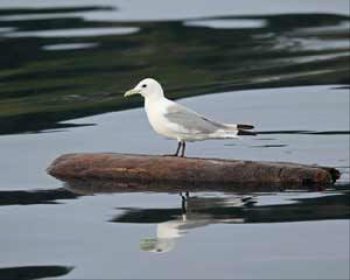Container Ships

|
I had a question in about Container Ships and fear about them and their loads causing floating hazards. I am awake in the middle of the night doing this to keep busy. Kate is 27 weeks pregnant now and has just been rushed in to Derriford Hospital because her blood pressure has gone sky high. So our thoughts and prayers go to Kate and Mark at this time. I will update as and when we know anything. Container Ships and Containers HOW MANY LARGE COMMERCIAL SHIPS ARE THERE IN THE WORLD? The worldwide commercial fleet is composed of about 90,000 ships with a total capacity of about 600 million tons. This is three times the number of commercial vessels that existed a century ago, and the number continues to grow. The merchant marine is the backbone of world commerce, transporting 95% of all merchandise by weight. In tonnage 60% of the ships that ply the seas are oil tankers and ore-transport ships, while 20% are container ships. One third of the world’s fleet sails under a “flag of convenience” (Liberian, Panamanian, Greek, Cypriot etc…) which, although requiring compliance with international maritime conventions, generally impose laxer rules regarding working conditions, nationality, and payment of crews than those associated with the flags of certain great powers. Next in percentage come Japan (10%), Russia (6%), and the U.S. (5%). As soon as Cyprus and Malta became members of the EU, Europe became the largest maritime power in the world. The transport of goods by sea is as successful as it is because of its intrinsic low cost. Shipping costs per ton are only 2.5% of the price by air, no energy is required to keep a ship afloat. Planes transport about one third of world commerce by value, usually made up of high value, light weight objects or rapid delivery items for repairs and emergencies etc.. In real terms it will cost us about 10 times the price of a first class air ticket to sail across the Atlantic. Whilst the wind is free, the initial outlay is not small, plus insurance, maintenance etc.... but I suppose the longer we sail the seas the cheaper these average costs become.
A container ship can be a welcome sight especially if you haven't seen another living thing all day. You can see them all along the horizon near shipping lanes. These ships can trundle along happily at an average speed of 24 knots. WHERE IS THE HEAVIEST SHIPPING TRAFFIC FOUND? Since the Roman times trading ships sailed straight across the Mediterranean. The need to trade between two ports for the exchange of goods has hugged the coasts, but the New World and the East has had trading routes for over 400 years. The main factors influencing commercial sea routes were still the same as those affecting the ancient world: winds, weather, ice and the topography of the planet. Winds cease to be a problem when steam ships replaced sails. The world’s topography was greatly modified when the Suez and Panama Canals were dug. Size of vessel determines where a ship can dock. The Panama Canal is undergoing major widening to rise from ships called Panamax to Super-Panamax.
BUT the big surprise is that with all the modern technology available to man, vast increases in world trade, commercial shipping routes have changed little over the last four centuries. HOW BIG A CREW DO LARGE COMMERCIAL SHIPS USUALLY CARRY? A large merchant ship usually has about 18 men aboard: the captain, 3 deck officers, 3 mechanics, 11 seamen and a cook. At night, an officer and a seaman stand watch. By day, the officer is usually alone on the bridge, but he can call crew from their workstations (administration, maintenance etc.) if he needs them. The seaman on watch are assisted by ARPA for Automatic Radar Plotting Aid that tracks the echoes coming from nearby ships setting off an alarm if there is a risk of collision. We have had experience of this several times, we always have our radar enhancer on (SEA-ME), a vessel monitors our track and literally goes around us. We attended a presentation given by a Panamax captain and he was not only in favour but enthusiastically endorsed the fitting of Sea Me as it made his job easier. Radio contact from commercial shipping SHOULD be in English, the maritime language. HOW MANY SHIPS ARE LOST AT SEA EVERY YEAR? According to statistics published by the Institute of London Underwriters, the number of commercial ships over 500 tons lost due to collision, running aground, sinking, or serious accident (fires) is about 100 per year. This represents an annual loss of 0.08% of the registered fleet by number and about half that by tonnage. In times of war the statistics obviously balloon. In World War II, the North Atlantic and particularly the English Channel was littered with sunken wrecks. Between 1939 and 1945, a total of 5150 merchant ships were sunk, 2800 of them by axis submarines. Approximately 600 warships and 1000 submarines sunk in the Atlantic and Pacific. Germany alone lost 785 submarines.
The Hyundai having a bad day. The Cosco Busan with a scarred port side. Arrival of the Ville D'Orion with 'a bit of movement', shame if it's your TV that fell in.
CONTAINER SHIPS. Container ships are cargo ships that carry all of their load in truck-size containers, in a technique called containerisation. They form a common means of commercial intermodal freight transport. The Columbo Express one of the largest container ships in the world, owned and operated by Hapag-Lloyd. HISTORY The earliest container ships were converted T2 tankers surplus after World War II. In 1951 the first purpose-built container vessels began operating in Denmark, and between Seattle and Alaska. On November 26th 1955 the purpose-built container ship Clifford J. Rodgers, carried 600 containers between North Vancouver and Skagway Alaska. The first purpose-built container ship in the United States was the Ideal-X, a converted T2, owned by Malcolm McLean, which carried 58 metal containers between Newark, New Jersey and Houston, Texas on its first voyage, in April 1956. Today, approximately 90% of non-bulk cargo worldwide is transported by container, and modern container ships can carry up to 15,000 twenty-foot equivalent units (TEU). As a class, container ships now rival crude oil tankers and bulk carriers as the largest commercial vessels on the ocean.
A variety of container ships
CONSTRUCTION Container ships are designed so that no space is wasted. Capacity is measured in twenty-foot equivalent unit (TEU), the number of standard 20-foot containers measuring 20 × 8.0 × 8.5 feet (6.1 × 2.4 × 2.6 meters) a vessel can carry. This not withstanding, most containers used today measure 40 feet (12 meters) in length. Above a certain size, container ships do not carry their own loading gear, so loading and unloading can only be done at ports with the necessary cranes. However, smaller ships with capacities up to 2,900 TEA are often equipped with their own cranes. Informally known as "box boats," they carry the majority of the world's dry cargo, meaning manufactured goods. Cargoes like metal ores or coal or wheat are carried in bulk carriers . There are large main line vessels that ply the deep sea routes, then many small "feeder" ships that supply the large ships at centralized hub ports. Most container ships are propelled by diesel engines, and have crews of between 20 and 40 people. They generally have a large accommodation block at the stern, near the engine room. Container ships now carry up to 15,000 TEU (approximately equivalent to 35 100-car double-stack intermodal freight trains) on a voyage. The world's largest container ship, the M/V Emma Maersk has a capacity of 15,200 containers.In 2008 the Korean shipbuilder STX announced plans to construct a container ship capable of carrying 22,000 TEU, and with a proposed length of 450 metres and a beam of 60 metres. If constructed, this container ship would the largest seagoing vessel in the world.
Container ships are loaded using computerised systems, whilst hugely efficient can sometimes get it wrong as seen in the crushed box. Captains only want to know if and where they have explosives, ie fireworks and refrigerated boxes in their load.
DO CONTAINERS THAT ARE LOST AT SEA REPRESENT A REAL DANGER? At any given time, between 5 and 6 million are being transported at sea. Container ships, seeking to maximise their payloads, carry three quarters of their cargo on deck, with the containers stacked 6 or 7 high. In bad weather the lashings are subjected to great strain and, not surprisingly, can break. Shipping companies do not make the reports of their losses at sea public, but it is estimated that between 2,000 and 10,000 containers are lost annually, about 0.005% of the total. These floating container-bergs are rarely watertight, it takes about two months for a 20 foot container to sink, about 6 months for a 40 foot. Refrigerated or thermal lined containers or those with huge amounts of polystyrene packaging, TV’s etc, may never sink. Calculating the risk these containers actually are is not easy. There have been some high profile collisions, Ellen MacArthur on her Kingfisher during the Vendee Globe, Josh Hall during the BOC Challenge, Steve Callahan during the Mini-Transat.
The sorry state of the MSC Napoli, a recent grounding off the otherwise beautiful Branscombe beach, Devon. The embarrassing scenes on the news of looters breaking open beached containers
A log pull, it's easy to see how 'one or two' of these could escape. Storm damage producing rogue logs. A Kittiwake quietly riding a log. In reality TREE TRUNKS are a greater danger. They fall off loaded barges, break loose from floating log convoys, or are simply washed out .to sea after storms have felled them or river floodwaters. And a tree trunk can remain afloat for ten years or more. According to Japanese statistics, there are an average of 40 tree trunks floating around every 10 x 10 mile square in the Pacific.
All in all the oceans are still immense, and the chance of running into one of these floating dangers head on is small compared with the other risks incurred when sailing the seven seas.
|



